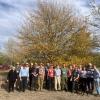Editor's Picks
Plant Focus
Hendrik Brand
Published May 2019 in International Oaks No. 30: 277–282
Abstract
The dehesa is a man-made ecosystem found in southwestern Spain and Portugal within which Quercus ilex subsp. rotundifolia is the most abundant tree species. There is a great variation in the size and tannin content of their acorns. In the last few decades a few threats have affected these oaks and their numbers have decreased over the years. The aim of this project is to conserve trees that produce low-tannin acorns, reproduce them vegetatively and plant them on a conservation site. In the southwestern Iberian Peninsula a team will investigate different dehesas to determine which trees produce acorns with the lowest tannin content. Cuttings will be taken from those trees, rooted in a nursery and planted on a conservation site. Once the trees are established, research can be undertaken to determine the causes of variation in the tannin content of acorns. Trees exhibiting tannin-content stability through time will be propagated and made available for agroforestry purposes for use in producing human and animal food.
Keywords
Quercus rotundifolia, holm oak, sweet acorns, human food, agroforestry
References
Costas, C.L. 2013. Manual de cocina bellotera para la era post petrolera. Licencia Creative Commons Atribución-Compartirlgual 3.0 Unported.
Gea-Izquierdo, G., I. Cañellas, and G. Montero. 2006. Acorn production in Spanish holm oak woodlands. Invest Agrar.: Sist. Recur. For. 15 (3): 339-354.
Moreno, G., M. Vivas, A. Pérez, E. Cubera, M. Madeira, and A. Solla. 2009. Soil properties linked to Phytophthora cinnamomi presence and oak decline in Iberian dehesas. Geophysical Research Abstracts Vol. 11, EGU2009-13868-1, 2009.
Olea, L., and A. San Miguel-Ayanz. 2006. The Spanish dehesa. A traditional Mediterranean silvopastoral system. Presentation at the 21st General Meeting of the European Grassland Federation (Badajoz, Spain).















